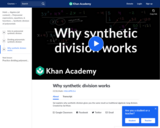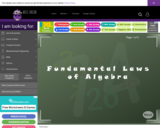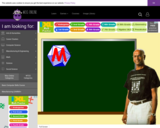
Equations with the variable on both sides.
- Subject:
- Algebra
- Mathematics
- Material Type:
- Lesson
- Provider:
- Khan Academy
- Author:
- Sal Khan
- Date Added:
- 09/22/2013

Equations with the variable on both sides.

Definitions of the vector dot product and vector length

Introduction to the notion of vector transformations

Determining the planar equation for a column space in R3

Visualizing the solution set for a system of inequalities

Prepared with pre-algebra or algebra 1 classes in mind, this module leads students through the process of graphing data and finding a line of best fit while exploring the characteristics of linear equations in algebraic and graphic formats. Then, these topics are connected to real-world experiences in which people use linear functions. During the module, students use these scientific concepts to solve the following hypothetical challenge: You are a new researcher in a lab, and your boss has just given you your first task to analyze a set of data. It being your first assignment, you ask an undergraduate student working in your lab to help you figure it out. She responds that you must determine what the data represents and then find an equation that models the data. You believe that you will be able to determine what the data represents on your own, but you ask for further help modeling the data. In response, she says she is not completely sure how to do it, but gives a list of equations that may fit the data. This module is built around the legacy cycle, a format that incorporates educational research feindings on how people best learn.

This set of problems for Linear Algebra in the open-source WeBWorK mathematics platform was created under a Round Eleven Mini-Grant for Ancillary Materials Creation. The problems were created for an implementation of the CC-BY Lyrix open textbook A First Course in Linear Algebra. Also included as an additional file are the selected and modified Lyryx Class Notes for the textbook.
Topics covered include:
Linear Independence
Linear Transformations
Matrix of a Transformation
Isomorphisms
Eigenvalues and Eigenvectors
Diagonalization
Orthogonality

This video is from the Khan Academy subject of Math on the topic of Algebra and it covers What is a function.

Understanding that a variable is just a symbol that can represent different values

Demonstrating why synthetic division gives you the same result as traditional algebraic long division

Jesse Roe and Sal Khan talk about why we use letters in algebra

Why we avoid using the traditional multiplication sign in algebra.

Learners review the fundamental laws of algebra including the commutative law of addition, the commutative law of multiplication, the associative law of addition, the associative law of multiplication, and the distributive law. Examples are given.

Learners try to figure out how The Mathemagician "reads their minds" and identifies the day of the month they were born. An explanation completes the interactive learning object.

Learners review the basic math operations involving zero, emphasizing that division by zero is undefined. Examples are given.

In this interactive object, learners simplify ratios and solve problems using proportions. All terms are defined.

Learners read definitions of the terminology associated with algebraic operations and then follow steps to simplify algebraic expressions.

Learners read definitions of the terminology associated with algebraic operations and then follow steps to use the fundamental laws of division to simplify algebraic expressions.

Learners read definitions of the terminology associated with algebraic operations and then follow steps to use the fundamental laws of multiplication to simplify algebraic expressions.

In this interactive object, learners examine the properties of equality and use those properties to solve simple equations.